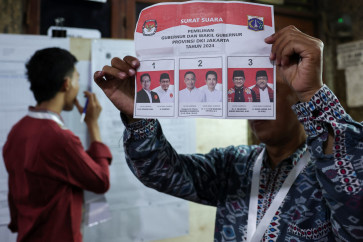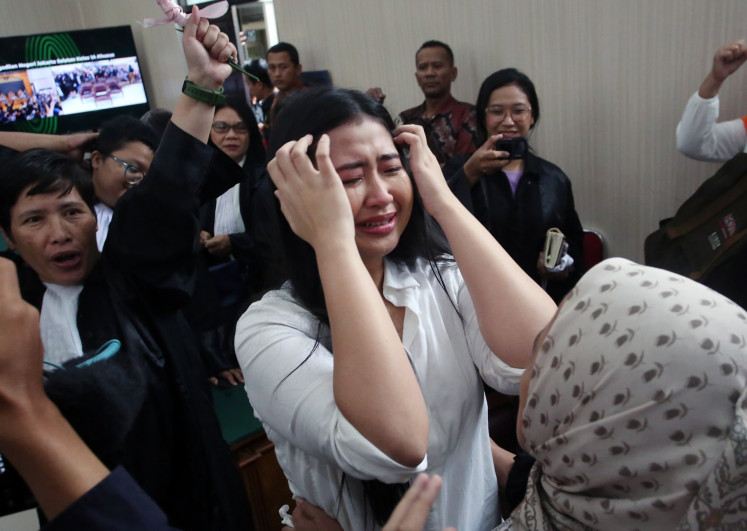Popular Reads
Top Results
Can't find what you're looking for?
View all search resultsPopular Reads
Top Results
Can't find what you're looking for?
View all search resultsIn Jakarta, kampungs coexist with skyscrapers
Change text size
Gift Premium Articles
to Anyone
T
hrough the eyes of the haves, the kampungs of the city might be unpleasant to look at. Dark, situated alongside alleyways and densely populated with little room for residents to move, kampungs may not represent modern, urban living.
The Jakarta administration has time and again focused on developing kampungs, which are considered by many to be the city’s slums. There have been construction projects and evictions at kampungs to polish Jakarta’s image as the metropolitan capital of the largest economy in Southeast Asia.
Even though kampungs are overlooked in city planning, they have managed to survive behind high-rise buildings, next to upscale gated communities and along the banks of the city’s rivers. However, even as skyscrapers and apartments continue to be developed, Jakarta kampungs – developed in a much quieter, simpler time – continue to remain.
Rita Padawangi, an urban expert from the Singapore University of Social Sciences, said this phenomenon could also be seen in the capital cities of other countries in the region. She noted that in Jakarta, rapid changes were made after Indonesia gained its independence in 1945.
The city’s main roads, Jl. MH Thamrin and Jl. Sudirman in Central and South Jakarta, had always been the “display window” of the city, she said.
“The roads [and buildings around them] are everything that are considered ‘good’,” she told The Jakarta Post on Monday.
“Meanwhile, kampungs that were around long before them are deemed less modern and need to be ‘repaired’ in order to keep up with people’s obsession with luxurious buildings.”
Kampungs versus high-rise buildings
Unlike New York City, which has a downtown and an uptown, Jakarta’s residential and business areas are scattered throughout the city.
Countless kampungs stand side by side with tall buildings, creating interdependent relationships among people of different socioeconomic statuses.
An example of this can been seen in the upscale Sudirman Central Business District (SCBD) in South Jakarta.
To serve hungry white and blue collar workers at lunch, food vendors in the area deliver their affordable meals through hole-in-wall establishments some 50 meters away from elite high-rise buildings. The vendors mostly operate from their own homes or relatives’ houses that border SCBD.
Rame-Rame Jakarta (Hustle and Bustle Jakarta) conducted research to analyze the benefits of mixed-income living in Karet, a kampung situated in the center of one of the busier business areas in Central Jakarta.
“The relationship between casual economic actors and the organized formal offices is one of love and hate, a dependency that is not always fully appreciated,” the report said.
Evictions at kampungs
Evictions at kampungs can be traced back to 1958 when then-president Sukarno planned to build sporting facilities to host the 1962 Asian Games in Senayan, Central Jakarta.
Under Jakarta’s first governor, Soemarno Sosroatmodjo, at least 60,000 people inhabiting four kampungs across Senayan were evicted to make way for the current Gelora Bung Karno sporting complex.
The 1980s, Rita said, was a time in which developers thrived as the sole housing providers, despite the fact that as business entities they worked toward profits, not based on the needs of the city.
“Those who needed affordable housing had no other choice but to move to urban kampungs. Kampungs became more crowded and there was a lack of infrastructure to support living there,” she said, noting that evictions were used by those in power to marginalize those with less power.
In 2015 and 2016, wide-scale evictions occurred under then-Jakarta governor Basuki “Ahok” Tjahaja Purnama, who now goes by “BTP”.
After taking over City Hall from his predecessor Joko “Jokowi” Widodo, BTP evicted people from residential and business areas to create more green spaces and develop infrastructure as part of a flood mitigation program.
The Legal Aid Institute (LBH) Jakarta recorded that these evictions affected more than 25,000 people.
During this same period, the city administration developed low-cost apartments and other facilities for the evictees.
Kampungs today
When Anies Baswedan was sworn in as Jakarta governor in 2016, kampung residents across the capital had high hopes, believing that Anies would fulfill his campaign pledge to not evict people from kampungs.
However, LBH Jakarta published in October last year a report that evictions had occurred throughout Anies’ first year in office. There were 79 evictions that affected 277 families and 864 areas where residents operated businesses.
Anies then introduced a program called Community Action Plan (CAP). The CAP, launched in May 2018 under a gubernatorial decree on kampung management, targeted 21 kampungs to redevelop using the regional budget.
The program gave residents the opportunity to work with the administration to find solutions to housing issues.
The program was implemented in kampungs affected by evictions, such as Kampung Kunir and Kampung Akuarium in North Jakarta. In those kampungs, the CAP provided evictees with temporary shelters.
In a recent interview with the Post, Kampung Akuarium activist Dharma Diani said despite the limitations, residents were grateful that they at least had roofs over their heads and walls to keep them warm.
“We’re still working on the CAP’s detail engineering design. We look forward to claiming back our land and legalizing and rebuilding our kampung,” she said.
Rita said the city should respect and preserve kampungs’ main characteristic: the spirit of working together in heterogeneous communities that exist within one area.
“There are ways to communicate and understand each other, solve conflicts and create partnerships and collaborations,” Rita said.











